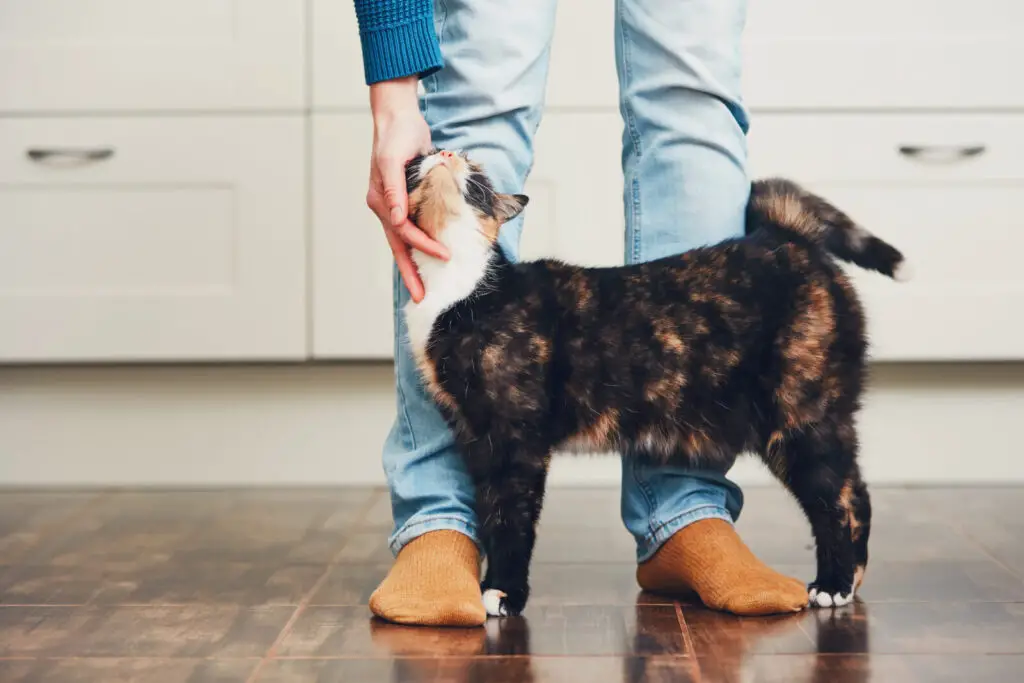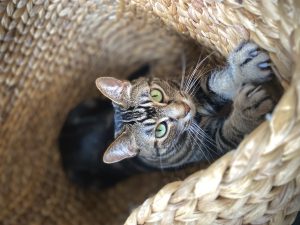Why Cats Purr – What Research Shows About this Fascinating Feline Phenomenon
Few sounds in nature are as captivating and mysterious as a cat’s purr. The gentle and steady rumble, like a tiny magic motor, has fascinated humans for millennia.
Myself included. Ever since I was a little kid, I’ve thought of purring as one of the very best sounds on the planet.
Despite our long history with cats, scientists are still unraveling the complexities behind this seemingly simple sound.
When your cat climbs into your lap and starts purring, they’re doing something truly remarkable in the animal kingdom.
It’s a unique vocalization and not only a sign of contentment – it’s a sophisticated form of communication and possibly even a natural healing mechanism.
In this article, we’ll explore the science behind why cats purr, uncover its various purposes, and reveal some surprising facts about this extraordinary feline phenomenon that sets domestic cats apart from most other animals.

What Is Purring?
A purr is a unique vocalization produced by the rapid twitching of muscles in a cat’s larynx (voice box) and diaphragm. These muscles contract and release about 25-150 times per second, creating the characteristic vibration we know as purring.
Unlike a meow, which cats only produce through exhaling, purring happens continuously through both inhaling and exhaling.
The Mechanics Behind the Motor
The exact mechanism of purring involves:
- Rapid muscle movements in the voice box
- Neural oscillations (signals from the brain) that trigger these movements
- Airflow across the vibrating muscles
- The diaphragm acting as a bellows to maintain the sound
What makes this even more fascinating is that cats can purr with their mouths completely closed. The sound is produced entirely through internal muscle movements, making it one of the most energy-efficient vocalizations in the animal kingdom.
Not Just House Cats
While domestic cats are the most famous purrers, they’re not alone in this ability. Several other members of the Felidae family can purr, including:
- Bobcats
- Cheetahs
- Lynx
- Ocelots
- Servals
The Uniqueness of Purring
What makes purring truly special is how it stands apart from other animal vocalizations. While many animals can produce repetitive sounds, true purring is a rare talent in the animal kingdom.
How Purring Differs From Other Cat Sounds
Unlike other feline vocalizations, purring has some distinct characteristics:
- It’s continuous through breathing cycles
- It can be produced with a closed mouth
- The frequency remains remarkably consistent
- It requires minimal energy to maintain
- It can be produced even when cats are injured or ill
Compare this to a cat’s other sounds:
- Meowing: Only occurs on exhale, requires an open mouth
- Hissing: A defensive sound that needs significant energy
- Growling: Also defensive, produced only while exhaling
- Chirping: Short, burst-like sounds that can’t be sustained
A Rare Ability
The ability to purr is so uncommon that scientists have only documented it in:
- About 20 species of small wild cats
- Domestic cats
- A few other animals (like raccoons and guinea pigs) that make purr-like sounds, but don’t truly purr
- Helps mother cats locate their babies
- Signals contentment during nursing
- Strengthens the mother-kitten bond
- May even help kittens coordinate breathing and nursing
The Happiness Connection
This one’s the most obvious – cats certainly do purr when content! Here are some common happy purring scenarios that probably won’t surprise you:
- During petting, grooming, or cuddling
- While relaxing in a favorite spot
- When greeting familiar humans or cats
- Before mealtime (often combined with meowing)
Cats will also purr at less expected times if they’ve been socialized to associate them with good things.
For example, my three cats actually purr with contentment while having their claws trimmed. Pretty much every time. I got an early start with my crew.
The Healing Hypothesis
But sometimes it’s the opposite of happy. Perhaps most fascinating is purring’s potential healing properties.
The frequency range of purring (25-150 Hz) has been shown to promote bone density, aid in muscle healing, reduce swelling, ease breathing, and help with pain management.
This may explain why cats often purr when things are rough. Here are some examples…
- Recovering from injury
- Giving birth
- Under stress (e.g., during a vet visit)
- In pain or discomfort
I have to give Phoebe a pill every day, and although she now purrs each time, it wasn’t like that in the beginning. I’ve worked hard to make pill-time as positive as possible, with snacks and loads of affection as rewards for her bravery.
So when she purrs, it makes me wonder if it’s because of stress, or all the positive attention surrounding the event. What’s absolutely clear is that she hasn’t grown to like the taste of the bitter pill!
But given that she comes to me when she hears the sound of pills rattling in the bottle, I think she actually does like the experience.
Self-Soothing Mechanism
Similar to the idea of self-healing, it is thought that cats also use purring as a self-calming technique:
- During stressful vet visits
- When anxious or uncertain
- While in labor
- In their final hours of life
Think of it as similar to how humans might hum, take deep breaths, or bite their nails to stay calm – purring appears to be a cat’s built-in stress management system.
Fascinating Facts About Purring
The more scientists study purring, the more intriguing discoveries they make. Here are some remarkable aspects of this feline superpower that might surprise you.
The Continuous Sound Loop
Unlike most animal vocalizations, a cat’s purr is unique in several ways.
For starters, it’s produced during both inhaling and exhaling, so the sound is maintained without interruption for long stretches of time. This is truly fascinating.
Purring is also generated without much energy expenditure. And cats can sustain it even while eating or drinking. Kinda crazy.
The Science of Sound Frequency
The frequency range of purring is particularly interesting.
Most cats purr within a range of 25-150 Hz. And this range happens to be the same as the frequencies used in:
- Medical bone healing treatments
- Muscle repair therapy
- Pain management
- Wound healing
Perhaps the people who claim that having a cat has health benefits are on to something there!
A Built-in Pain Management System
Taking the idea of the potential healing power of purring even further, consider these facts about cats’ responses to trauma…
- Recover from surgery faster than dogs
- Have fewer complications from falls
- Heal bone injuries more quickly than many other animals
- Show remarkable resilience to certain types of injuries
The Magic of Purring for Humans
That soothing rumble from your lap-warming pal does more than just signal their contentment – it may just have effects on your wellbeing too.
A Calming Effect with Physical and Psychological Benefits
Research suggests that a cat’s purr may actually:
- Lower blood pressure
- Reduce stress levels
- Decrease anxiety
- Promote restful sleep
- Create a general sense of wellbeing
So it wouldn’t be surprising that purring appears to contribute to things like muscle tension relief, improved bone density, reduced inflammation, better breathing patterns, and enhanced healing of minor injuries.
And this is why cats are increasingly used in animal-assisted therapy, senior care facilities, stress management programs, pain management support, and recovery programs.
Indeed, a small number of studies suggest that cat owners experience fewer heart attacks, lower risk of cardiovascular disease, and reduced risk of stroke.
A Natural Antidepressant?
And on the mental health side of things, cat owners have been found to have improved mental health outcomes. Regular interaction with a purring cat may…
- Boost serotonin levels
- Reduce cortisol (stress hormone)
- Increase oxytocin (bonding hormone)
- Improve overall mood
- Create a sense of connection
More research is needed. But I count it all among the reasons why you should have a cat!
Last Meows
A cat’s purr represents one of nature’s most elegant solutions – a simple sound that functions as a communication tool, healing mechanism, stress reliever, and bonding aid.
This remarkable ability has helped cats survive and thrive alongside humans for thousands of years.
So the next time your cat purrs, remember what you’re experiencing:
- An evolutionary marvel millions of years in the making
- A sophisticated healing mechanism
- A natural stress management system
- A powerful form of communication
- One of nature’s most efficient therapeutic tools
Whether your cat is purring from happiness, self-soothing, or trying to tell you dinner is late, they’re using one of the animal kingdom’s most remarkable adaptations.
